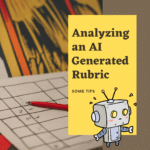Whether you use ChatGPT, Google Bard, Bing (which is ChatGPT), so some other Artificial Intelligence chatbot it is set to transform how you teach! Not only can you save time with chatbots, but you can innovate your teaching. ChatGPT can do some of the heavy lifting to help you make creative lesson plans and projects. Innovate Teaching with ChatGPT (AI)
Innovative Teaching with ChatGPT: Empowering Teachers to Enhance Pedagogy, Not Just Efficiency
Once again I am teaming up with OTIS to bring you a course, this time on ChatGPT. Check out the recording on the OTIS website. First create a free OTIS account.
In this course, Alice Keeler will explore the ways in which ChatGPT can be used to empower teachers to enhance their pedagogy; encourage creativity and critical thinking; facilitate student-centered learning experiences; and integrate PBL activities. She will also discuss the importance of ethical use of ChatGPT by using it to facilitate deeper learning and not as a replacement for critical thinking or simply to make task more efficient. Join us to explore this cutting edge AI tool!
The evolution of technology in education has opened new doors for innovative teaching methods. One such groundbreaking tool is ChatGPT, a large language model developed by OpenAI. It has immense potential to not only improve efficiency, but also to enhance pedagogy for a more engaging learning experience. Explore how ChatGPT can empower teachers to foster creativity, critical thinking, student-centered learning, and project-based learning (PBL) activities. Also consider the ethical use of ChatGPT, emphasizing its role in facilitating deeper learning rather than replacing critical thinking or simply boosting efficiency.
Encouraging Creativity and Critical Thinking
ChatGPT is a versatile AI tool that can be utilized to encourage creativity and critical thinking in students. Teachers can use it to generate thought-provoking prompts, questions, or discussion topics that encourage students to think beyond the obvious. By challenging students with open-ended questions or presenting them with novel ideas, educators can cultivate a learning environment that promotes divergent thinking and problem-solving skills.
Facilitating Student-Centered Learning Experiences
With its ability to understand and respond to natural language, ChatGPT can help teachers create personalized learning experiences for their students. For instance, educators can leverage the AI model to design individualized study plans, provide targeted feedback, or offer supplementary resources tailored to each student’s needs and interests. This ensures that learning is student-centered and that each student receives the necessary support to succeed.
Integrating Project-Based Learning Activities
ChatGPT can also be an invaluable resource for integrating PBL activities into the curriculum. It can assist teachers in designing engaging, real-world projects that encourage students to apply their knowledge and skills to solve complex problems. By providing ideas, resources, or suggestions for project themes and tasks, ChatGPT can help educators create immersive, hands-on learning experiences that foster collaboration and a deeper understanding of subject matter.
Ensuring Ethical Use of ChatGPT
While ChatGPT offers a wealth of benefits, its ethical use is paramount to ensure responsible integration in educational settings. Teachers should avoid utilizing ChatGPT as a shortcut, as doing so could be perceived as cheating. Instead, they should employ it as a supplementary tool to facilitate deeper learning and enhance the overall learning experience.
When using ChatGPT, it’s important to acknowledge the sources of information it generates. Since ChatGPT is trained on a vast dataset, it may inadvertently reproduce copyrighted content. Teachers must exercise caution to prevent violating copyright laws and should encourage students to verify and properly cite the information provided by the AI.
Educators must also be prepared to address the ways in which students may use ChatGPT. With easy access to the technology, students might be tempted to rely on it for completing assignments or generating ideas, thus bypassing the learning process. This calls for a reevaluation of what constitutes cheating in the age of AI, and the development of guidelines that promote responsible use of AI tools like ChatGPT.
In addition, educators should be aware of the potential biases and limitations of AI models. By educating students about these concerns, teachers can help them understand the importance of critical evaluation, ethical considerations, and responsible use of technology. This will empower students to be discerning users of AI tools, ensuring that they harness the potential of ChatGPT in a conscientious manner.
Innovate Teaching with ChatGPT (AI)
ChatGPT has the potential to revolutionize teaching by empowering educators to enhance their pedagogy, rather than just increasing efficiency. By incorporating this AI tool into the classroom, teachers can foster creativity, critical thinking, student-centered learning, and project-based learning experiences that lead to a deeper understanding of subject matter. As with any technology, it is crucial to use ChatGPT ethically and responsibly, ensuring that it serves as a facilitator for learning rather than a replacement for critical thinking or a means to simply boost efficiency.
- 4 Tricks For When You Copy and Paste Off the Internet
- What the Heck is AI and Why Does Every Product Have It?
- Robot: Write Me an Article on Teaching with Google Slides
- 100 Prompts for Teachers to Ask ChatGPT
- Google Explore, What Happened to It?
-
10 Ways Teachers Can Unleash the Power of Appsheet
AppSheet lets teachers build their own apps without code! Here are 10 ways to use AppSheet for teachers for custom classroom solutions.
-
CTRL L: Leveling Up Student-Centered Learning with a Simple Shortcut
The simple shortcut Ctrl+L might seem insignificant, but it can be a powerful tool in a student-centered classroom.
-
Chrome for the Classroom: Essential Updates Every Teacher Should Know
Chrome is always improving. If you use Chrome for the classroom you will want to check out these essential updates.
-
30 Keyboard Shortcuts That Teachers Need
The secret to feeling more confident on the computer is keyboard shortcuts! Here are 30 Keyboard Shortcuts That Teachers Need
-
Hide All Tabs – Google Sheets
Have a lot of tabs in your Google Sheets spreadsheet? Here is how to hide all tabs at once, quickly.
-
Transform Your Lessons: The Power of Desmos Classroom Computation Layer
Take Desmos Classroom even further with the computation layer. Customize your lesson with the CL.















